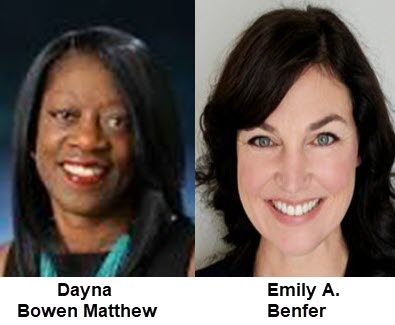Abstract
Excerpted From: Dayna Bowen Matthew and Emily A. Benfer, A Clarion Call for Change: The MLP Imperative to Center Racial Discrimination and Structural Health Inequities, 51 Journal of Law, Medicine & Ethics 735 (Winter 2023) (73 Footnotes) (Full Document)
 With over 450 sites across forty-nine states and the District of Columbia, the medical-legal partnership (MLP) field has made major strides towards achieving the initial goal of an integrated health care system that leverages social and legal services to achieve positive health outcomes among low-income patients. Across the country, legal and health care professionals who understand that health outcomes are most influenced by social and environmental conditions have embraced the model and changed the practice of medicine permanently. As one MLP provider stated, “medical-legal partnership puts the humanity back in medicine ... [it] changes the way doctors practice medicine for the rest of their lives.”
With over 450 sites across forty-nine states and the District of Columbia, the medical-legal partnership (MLP) field has made major strides towards achieving the initial goal of an integrated health care system that leverages social and legal services to achieve positive health outcomes among low-income patients. Across the country, legal and health care professionals who understand that health outcomes are most influenced by social and environmental conditions have embraced the model and changed the practice of medicine permanently. As one MLP provider stated, “medical-legal partnership puts the humanity back in medicine ... [it] changes the way doctors practice medicine for the rest of their lives.”
To treat the whole patient, hundreds of health care and legal providers have formed MLPs, integrating lawyers and law students into the medical team in nearly all health care settings--from federally qualified health centers and hospital systems to telehealth and specialty practices--to serve the most vulnerable patient populations, including children and infants, elderly people, cancer patients, immigrants, veterans, and formerly incarcerated individuals, among others. The positive results are widespread and significant: hospital admission rates are reduced among people with chronic illness; patients experience less stress and improved mental health outcomes; and emergency department visits decrease. The use of preventative health care increases, resulting in a reduction of health care spending on high-need, high-cost patients. In addition, health care costs are reduced, and health care and clinical services are more frequently reimbursed by public and private payers. Patients also report experiencing improvements in housing and utility needs (82%), personal and family stability needs (73%), education and employment needs (53%), as well as reduced stress (79%). The model's success is further amplified in support from the U.S. Department of Justice and Legal Services Corporation, as well as resolutions from the American Bar Association, American Medical Association, and the American Academy of Pediatrics that encourage and promote the development of MLP to “identify and resolve diverse legal issues that affect patients' health and well-being,”
Despite these outcomes and the rapid growth of the collaborative and interdisciplinary health care delivery model, the MLP field will not and cannot achieve population health, let alone long-term health equity, until it mobilizes and broadens partnerships to address the structural determinants of health inequity that are rooted in institutional racial discrimination, segregation, and implicit bias, as well as other forms of subordination. This article draws from the Supreme Court dissenting opinions in Students for Fair Admissions, Inc. v. President and Fellows of Harvard College, together with Students for Fair Admissions, Inc. v. Univ. of North Carolina, as legal epidemiology to describe the harm of overlooking the structural determinants of health, specifically racial discrimination. The court's clarion call underscores the urgent need for the MLP field to address the underlying structural determinants of health that are memorialized in U.S. law and policy and seen all too clearly in health disparities among low-income and historically marginalized MLP patients and communities. With MLPs firmly established in hundreds of hospitals, health centers, legal services organizations and law schools, the national MLP movement is now called to commit to anti-racism and adopt as a core goal the elimination of structural discrimination.
[. . .]
As the dissenting opinions in Students for Fair Admissions, Inc. so clearly laid bare, the structural determinants of health, including racial discrimination, poverty, and other vehicles of subordination and subjugation, threaten the health and livelihood of millions of Americans. The MLP field must shift its focus, and build capacity, to address the longstanding and racially discriminatory underpinnings of poor health among patients. There is no better model than the MLP, with the combined expertise of medical and legal champions, to address discrimination within the structural determinants of health inequity. Especially as the Supreme Court's threats to dismantle seminal civil rights laws increase and so-called “originalist” theorists ignore the health effects of centuries of discriminatory harms, it is paramount that the MLP movement answer the clarion call to center racism and work collaboratively to eliminate racial discrimination and structural health inequities as the next and only step forward.
Dayna Bowen Matthew, J.D., Ph.D., is the Dean and Harold H. Greene Professor of Law at the George Washington University Law School.
Emily A. Benfer, J.D., LL.M., is an Associate Professor of Clinical Law and the Director of the Health Equity Policy & Advocacy Clinic at George Washington Law School and a Research Collaborator at the Princeton University Eviction Lab.


